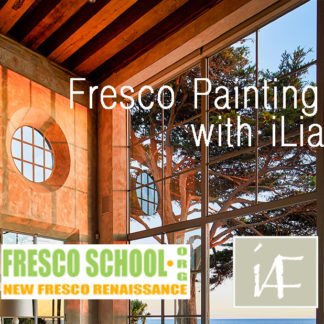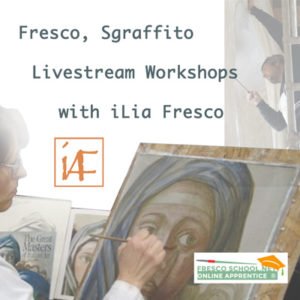Marmorino plaster (Roman Marmorino) is a mixture of aged lime putty and marble dust or marble meal. Proportions do vary, but generally it is 1 part of Lime Putty – to – 1 part of marble dust (or meal). Traditionally there could be added ingredients like linseed oil or olive soap, but often marmorino is just polished/sealed with those.
The term “marmorino” simply denotes that the aggregate is marble dust/meal instead of sand in “intonaco” plaster. Intonaco (direct translation “plaster”) as a term that refers to the top layer of plaster. So marmorino is intonaco and intonaco is marmorino. Both made with main active ingredient – Slaked Lime Putty. So you can paint straight on it as it is a Buon Fresco.
Brief History:
Marmorino plaster has Greek origins where it was used for high polished surfaces and to bring second grade marble to a consistent, fine grade white marble, look. With that “marble make over”, a second grade marble is cut and installed, all exposed surfaces are brought to a sand finish. In the next step, sand finished surface is coated with marmorino plaster, polished and sealed with linseed oil and/or olive soap. The one can see “marmorino residue” on the remnants of Ancient Greek stonework. Next time you are in Greece, check that out!
Many sources date marmorino plaster use to all the way back to the Ancient Egypt. The Great Pyramids of Gaza (and others) were polished with white marmorino plaster. They used to shine under a desert sun absolutely white! Records say that ancient Egyptian plasterers used human saliva to polish the marmorino plaster.
Fresco Painting Technical Notes:
Marmorino plaster ratio is dense. When applied, it has limited ability to accept paint, multiple paint layers or opaque paint mixes. During the Renaissance, to accommodate for the advances in painting (value principles, aerial perspective, etc.) which require multiple layers of paint. Marmorino plaster was replaced by the classic plaster ratio of 1 to 2 (referred to as Intonaco – plaster direct translation from Italian, also used to refer to the final painting plaster layer) – 5 part lime putty to 8 parts of the aggregate – sand and/or marble meal (for pure white plaster). …more on fresco plaster coats
However this plaster provides a beautiful marble-like surface as it is. In recent art history, the most notable is Diego Rivera who has adopted this plaster and used watercolor approach to work on it.
Natural pigments are added into the plaster to slightly alter/shift the color. For deep colors different, sand based plaster known as Venetian Plaster, is preferred.
The main differences between Marmorino Plaster and Venetian Plaster is the color and the aggregate. Venetian Plaster is colored and Marmorino Plaster is either pure white or slightly tinted. The aggregate for the Marmorino Plaster is predominantly crashed Marble and for the Venetian plaster it is mainly river sand.
The commercially produced “marmorinos” may contain a lot of other additives like acrylics, and other glues to help with application, which is not a true marmorino, so you need to make sure there is lime in it to be able to paint on it, and do some tests on a samples.
Our marmorino plaster – Roman Marmorino is pure. It is made with extra-mature slaked lime putty and select, hand-sifted marble dust.
Brief step-by-step example of use – Celestial Buon Fresco Sgraffito Fireplace Mantel, by iLia Fresco







